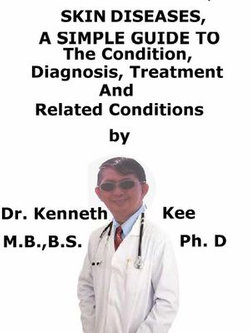This book describes Skin Diseases, Diagnosis and Treatment and Related Diseases
Skin is the soft outer covering of human.
The human skin is the biggest organ (15% total body weight) of the body and forms the outer covering of the body.
The skin has multiple layers of ectodermal tissue and protects the underlying muscles, bones, ligaments and internal organs.
While nearly all human skin is covered with hair follicles, it can appear hairless.
There are two normal types of skin:
1.Hairy – most skin areas are hairy
2.Glabrous skin. – Hairless, present in the palms and soles
The skin for the average adult human has a surface area of between 1.5-2.0 square meters (16.1-21.5 sq ft.) with most of it between 2–3mm (0.10 inch) thick.
The average square inch (6.5sq.cm) of skin holds:
1.650 sweat glands,
2.20 blood vessels,
3.60,000 melanocytes and
4.More than 1,000 nerve endings.
The Skin is divided into:
- The epidermis which supplies waterproofing and functions as a barrier to infection
- The dermis which functions as a location for the appendages of skin
- The hypodermis (subcutaneous adipose layer).
The skin is one of the most important parts of the body because it interfaces with the environment and is the first line of defense from external factors.
The Functions of the Skin are:
The main function is as a protective and elastic covering of the human body.
Since it interacts with the environment, the skin has a key part in protecting the body against pathogens and excessive water loss.
Its other functions are:
1.Insulation,
2.Temperature regulation,
3.Sensation,
4.Synthesis of vitamin D, and
5.The protection of vitamin B folates.
Severely injured skin will try to repair by forming scar tissue.
This is frequently discolored and de-pigmented.
Skin and Its Micro-organisms
The skin has its own ecosystems of microorganisms including yeasts and bacteria which cannot be removed by any quantity of cleaning.
Estimates place the number of individual bacteria on the surface of one square inch (6.5 square cm) of human skin at 50 million though this figure differs greatly over the average 20 square feet (1.9sq.m) of human skin.
Oily surfaces such as the face may contain over 500 million bacteria per square inch (6.5sq.cm).
All of the bacteria found on the skin's surface would fit into a volume the size of a pea.
Aging
As skin ages, it becomes thinner and more easily damaged.
Photo-aging has two main concerns: - An increased risk for skin cancer
- The appearance of damaged skin.
In the older population the skin becomes thinner and the epidermis turnover rate for cell repair is lower which may result in the dermis layer being damaged.
Skin Cancer
With over 1 million new cases each year, skin cancer is the most common form of human cancer.
There are three types of skin cancer: basal cell carcinoma, squamous cell carcinoma, and melanoma.
Cellulitis is a common infection of the lower layers of skin (dermis) and the subcutaneous tissues (areas underneath the skin) caused by a bacterial infection.
Staphylococci are the bacteria that most commonly cause cellulitis, followed by Streptococci.
Molluscum contagiosum is a common skin disorder caused by a superficial skin infection with the poxvirus.
Pityriasis rosea is a common rash usually seen in individuals
Psoriasis is a noncontagious skin condition that produces red, dry plaques of thickened skin.
Eczema is a skin condition caused by inflammation.
Atopic dermatitis is the most common of the many types of eczema.
Vitiligo is a pigmentation disorder in which melanocytes in the skin are destroyed.
Lichen Planus is a chronic inflammatory disease of the skin.
Keloid is an overgrowth of fibroblastic tissue in scars.
TABLE OF CONTENT
Introduction
Chapter 1 Skin
Chapter 2 Skin Diseases
Chapter 3 Vitiligo
Chapter 4 Lichen Planus
Chapter 5 Atopic Dermatitis
Chapter 6 Keloid
Chapter 7 Melanoma
Chapter 8 Psoriasis
Epilogue



Share This eBook: